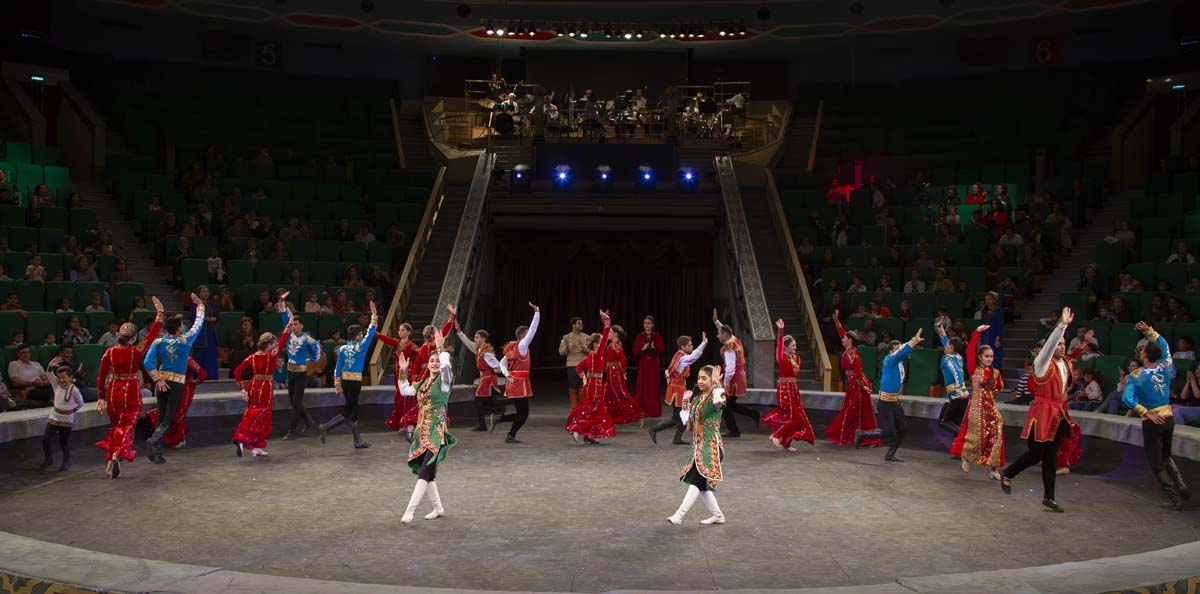The exposition showcases the exhibits kept in the depositories that tell about the rich historical and cultural heritage of the Turkmen people since the Jeytun culture that existed in Southern Turkmenistan in IV-V millennia B.C.

The theme of the efficient use of water resources is reflected in the exposition section “Nature and local studies” that presents the hydrographic system of large transboundary rivers in our country – the Amu Darya, the Murgab and other rivers as well as small rivers, flowing down from the northern slopes of the Kopetdag Mountains. The map shows the river bed, a network of canals and collectors of the man-made Karakum River. The branched water and economic complex of the country also includes the collector-drainage system of the Altyn Asyr Lake. Moreover, Turkmenistan has huge reserves of subsoil waters, including freshwater.

The ethnographic section is devoted to the use of water in agriculture. For thousands of years, our ancestors have formed a farming culture using artificial irrigation systems. Archeologists find the fragments of dams, water intakes, small main canals on the territory of Ahal, Lebap and Mary velayats. The most esteemed fellow villagers were entrusted to distribute water. Mirabs controlled the regime of water use and kept ditches and dams clean.

There is an interesting model of jikyr - a device in the form of a large wheel with jugs for taking water and raising it to the level of the field. The construction of the vertical wheel could be supplemented with a horizontal wheel fixed with the vertical wheel, and it was driven by a camel walking around in circles with blindfolded eyes. These devices were actively used since the VI-VII centuries until the beginning of the last century. Another unique method of irrigation is the irrigation with the help of the underground channel - kyariz, the principle of operation of which can be understood by considering a special exhibit in the museum. With the help of an underground hydroelectric water, the foothills were extracted from the bowels, collected in a stream and descended into the valley. Such a network of vertical wells connected by a gallery could have a depth of up to 50 meters. History has preserved interesting traditions associated with their construction, reconstruction and cleaning.

The theme of the efficient use of water resources is reflected in the exposition section “Nature and local studies” that presents the hydrographic system of large transboundary rivers in our country – the Amu Darya, the Murgab and other rivers as well as small rivers, flowing down from the northern slopes of the Kopetdag Mountains. The map shows the river bed, a network of canals and collectors of the man-made Karakum River. The branched water and economic complex of the country also includes the collector-drainage system of the Altyn Asyr Lake. Moreover, Turkmenistan has huge reserves of subsoil waters, including freshwater.

The ethnographic section is devoted to the use of water in agriculture. For thousands of years, our ancestors have formed a farming culture using artificial irrigation systems. Archeologists find the fragments of dams, water intakes, small main canals on the territory of Ahal, Lebap and Mary velayats. The most esteemed fellow villagers were entrusted to distribute water. Mirabs controlled the regime of water use and kept ditches and dams clean.

There is an interesting model of jikyr - a device in the form of a large wheel with jugs for taking water and raising it to the level of the field. The construction of the vertical wheel could be supplemented with a horizontal wheel fixed with the vertical wheel, and it was driven by a camel walking around in circles with blindfolded eyes. These devices were actively used since the VI-VII centuries until the beginning of the last century. Another unique method of irrigation is the irrigation with the help of the underground channel - kyariz, the principle of operation of which can be understood by considering a special exhibit in the museum. With the help of an underground hydroelectric water, the foothills were extracted from the bowels, collected in a stream and descended into the valley. Such a network of vertical wells connected by a gallery could have a depth of up to 50 meters. History has preserved interesting traditions associated with their construction, reconstruction and cleaning.






